How Long Does It Take For Potatoes to Grow? How to Grow Potatoes Properly?
by Lee Safin
The average price for potatoes in supermarkets is probably among the cheapest of all vegetables. Plenty of main dishes and side dishes are made from them. Bread recipes, pasta dishes, and sweets can all be made using them.
But the question is— how long does it take for potatoes to grow?
Approximately 80-100 days are required for the maturation of full-sized potatoes to grow. So we can say that it takes up to 4 months to grow potatoes with their full potential. However, the period can vary depending on the type.
In some seemingly inconsequential circumstances, like in a shopping bag, potatoes grow impressively well. This is why growing potatoes at home is a popular hobby for people with a passion for gardening.
But many things depend on growing potatoes. Please scroll down for a few minutes if you wish to learn more about them.
Contents
- How Long Does It Take To Grow Potatoes?
- Things That Affect the Growth Of Potatoes
- How to Grow Potatoes Properly?
- 7 Useful Tips to Grow Potatoes Fast
- Try Vegetative Propagation Method to Grow Potatoes
- What is The Best Spacing Between Potato Seeds?
- What are the ways to grow potatoes?
- Should You Harvest Potatoes After Maturity?
- Which Fertilizer is Most Effective for Potatoes?
- Can a potato that has not sprouted be planted?
- What is the best way to increase potato yield?
- Is it faster to sprout potatoes in the dark?
- What is the average number of potatoes per plant?
- Conclusion

How Long Does It Take To Grow Potatoes?
There are multiple answers to this single question “how long does it take for potatoes to grow?” In general, the type of potato you seed will determine how long does it take for potatoes to grow.
Potatoes come in three different types: starchy, waxy, and medium or all-purpose. The maturation periods of each type of potato vary.
1. Early-season Varieties
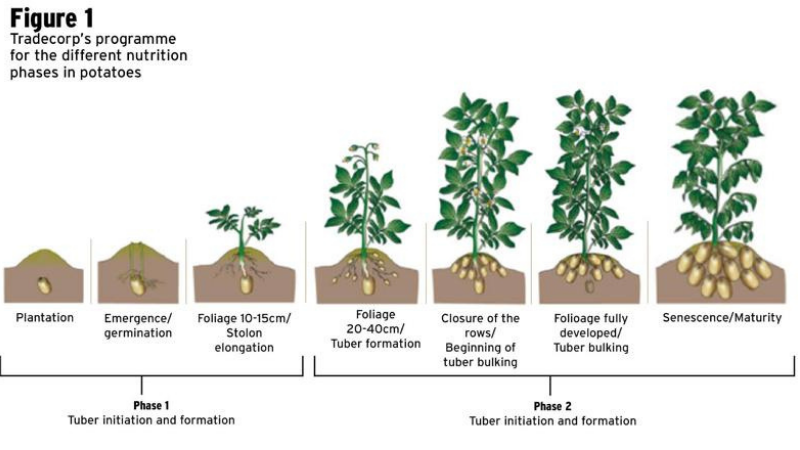
The maturation period of early potato varieties is shorter. In most cases, they become fully mature within 90 days of seeding.
Therefore, if you live in a cool place, they may be a good fit for you. Also, in case you want to harvest early, they might be a good match.
Early potatoes like King Harry are pretty popular. During the growing season, this variety can withstand potato beetles. Charlotte is another early potato variety, and the skin of this variety is thin light brown. ‘Maris Peer, Kestrel, Winston, Jazzy, Vivaldi, etc., are the most famous early potatoes.
Mid-season Varieties
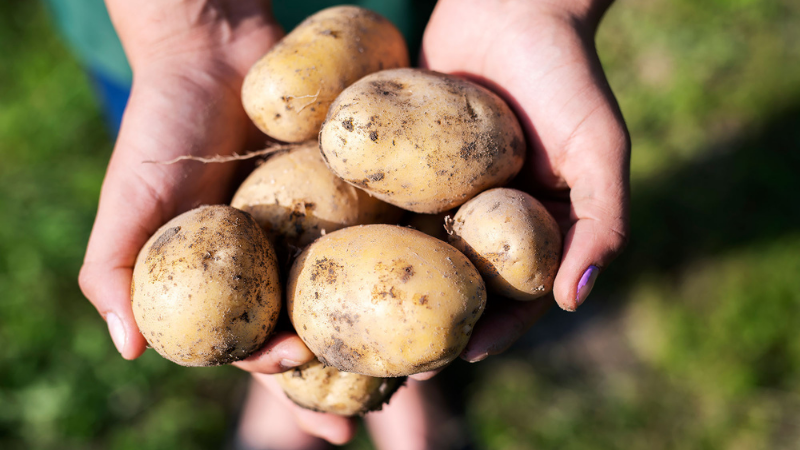
It usually takes about 100 days for mid-season varieties to reach maturity after seeding. A warm climate is ideal for growing them.
Catalina, Gold Rush, Chieftain, Kennebec, Ida Rose, Purple Viking, etc., are the top popular mid-season potato varieties.
Late-season Varieties

It’s probably best to plant a late variety of potatoes if you intend to store potatoes throughout the winter.
About 110 days are usually needed for this category of potatoes to reach maturity. Climates with warm temperatures are best for growing them. Long-term storage is possible for them.
- Bintje
- Elba
- Canela Russet
- German Butterball
- Desiree
- Lehigh, etc.
These are the most popular late-season potato varieties.
Things That Affect the Growth Of Potatoes
How long does it take for potatoes to grow will depend on many factors? Here are them.
1. Certification of seed potatoes
It is best to purchase organic and certified seed potatoes from authentic sources. Plus, it is a bad idea to use seed potatoes from supermarkets.
A chemical is applied to most store-bought potatoes to prevent sprouting. Compared to certified seed potatoes, store-bought seed potatoes are more susceptible to disease.
You should discard any potatoes that show signs of disease before saving your own seed potato. Among the possible symptoms are discoloration, soft, wrinkled tubers, etc.
2. Soil Type


Soil with good drainage is ideal for seed potatoes. The minimum temperature of the particular soil should be 40 degrees Fahrenheit.
Ideally, seed potatoes can’t grow favorably well on cold, waterlogged soil because rot will happen to the pieces.
Sow seed potatoes in raised beds if you have clay soil that is poorly drained. Improved drainage and reduced rot will be the results.
Before planting, you can improve soil conditions by adding organic matter. For example, you can add compost and get rid of the rotted leaves or manure.
3. Taking Care of Potato Seeds


The management of seed potatoes affects the growth of the plant. To grow seed potatoes, you should cut them into pieces 1 1/2-inches or bigger with at least two eyes. The tubers are planted whole if they are egg-sized or smaller.
Cutting seed potatoes make them more prone to bruises than whole seed potatoes. Cells can be damaged and become more vulnerable to disease when you plant whole seed potatoes.
These bruised areas can easily carry diseases from the soil or existing on the tubers, and it may prevent the natural growth of potato seeds.
How to Grow Potatoes Properly?
How long does it take for potatoes to grow often depends on the method you are applying to grow them. Here we are mentioning a step-by-step method to grow potatoes quickly.
Step 1 — Selecting seed potatoes
Try to choose disease-free and organic seed potatoes from a nursery, as we mentioned above. You should choose sprouted tubers if you acquire them from a farm store. Alternatively, place them on the kitchen counter to sprout.
Potatoes that have been sprouted can be harvested a few weeks earlier than those that have not yet sprouted.
Step 2 — Splitting the eyes apart
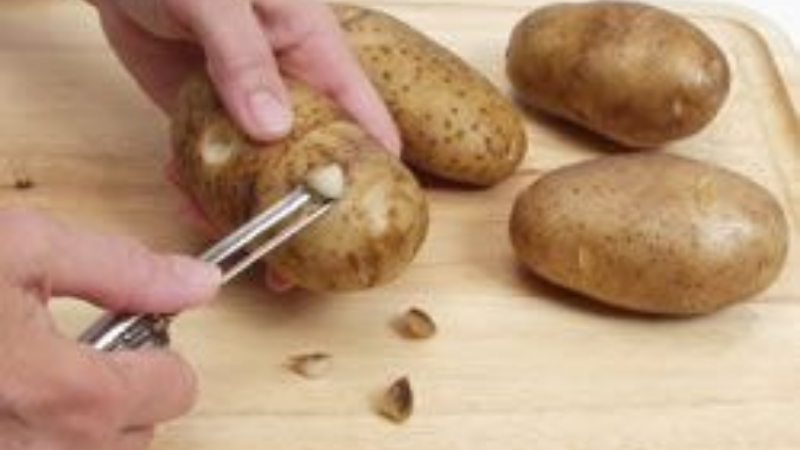
Potatoes should only be planted whole if they are smaller than a golf ball. Make small pieces of large tubers. By cutting so, segments are divided into two or three eyes
In order to keep the potato plant from becoming overcrowded and multi-stemmed, it should be cut into parts. A stem of potatoes will only bear small potatoes because it is competing for moisture and food.
Step 3 — Curing the cut pieces
“Cure” the pieces once the cutting process is completed. Either keep them outside in the direct sunlight or set them out on a counter or table, preferably in a warm environment (22°C) for 4-5 days.
As a result of this procedure, Calloused skin forms. It is a good idea to make them calloused to keep them from rotting.
Step 4 — Potato planting time and instructions
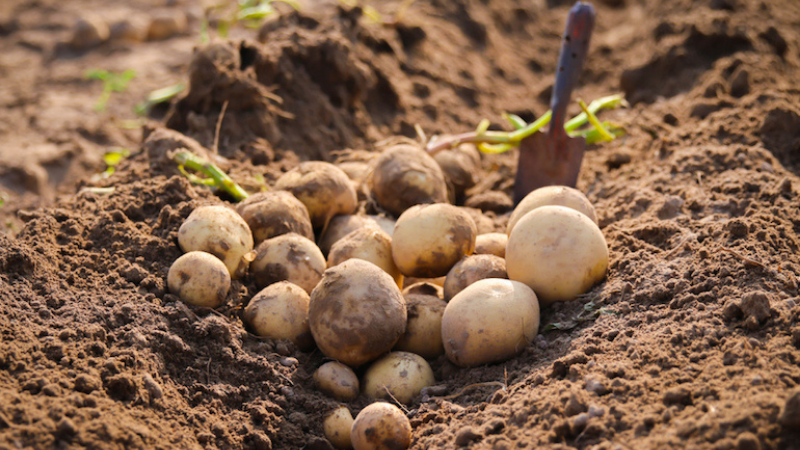
Dig a trench or hole in a 6-inch-deep and place the potato seed segments cut-side up in the ground. On all sides, separate segments by 12 inches.
Sprinkle two tablespoons of a high-phosphorous, low-nitrogen fertilizer between each segment. Add 2 inches of soil around the potatoes as well as the fertilizer, and don’t forget to water it.
Potato planting occurs at various times of the year, depending on your geographic location. The planting season around Valentine’s Day is particularly popular with gardeners in warmer climates.
Those who live in cooler climates may plant them around early spring or Easter. A few weeks prior to the last frost date is the ideal time to start your seeds.
Step 5 — Stems Around the Hill
On lateral stems, new potatoes are formed. That’s why the vines must be hilled. Bury everything but the top 4 inches of the green sprouts with soil, chopped straw, or shredded leaves when they reach 8 inches tall.
Once the potato plant grows another 8 inches, hill it again. A more prosperous harvest is likely if you hill more frequently. Our standard height for hills is 18 inches. During the flowering of the vines, stop hilling them.
Potato tubers, such as vampires, must live in dark conditions. Their color will change to green when exposed to light. You have the probability of becoming sick from consuming green potatoes. That’s why it is essential to cover the tubers with soil or mulch at all times.
Step 6 — Potato harvesting season & instructions
The vines can be reached into the ground or mulched two weeks after they have flowered. Several baby potatoes can be retrieved if you want. Alternatively, the vines must die back before harvesting.
A vine that is dead indicates that tubers are mature. Now, pull the tubers upward from the soil with your hands.
How long does it take for potatoes to grow? It takes about ten weeks for small new potatoes to become ready. But, about 80-100 days are needed for mature potatoes to reach their full size.
Step 7 — Potatoes: How to store them
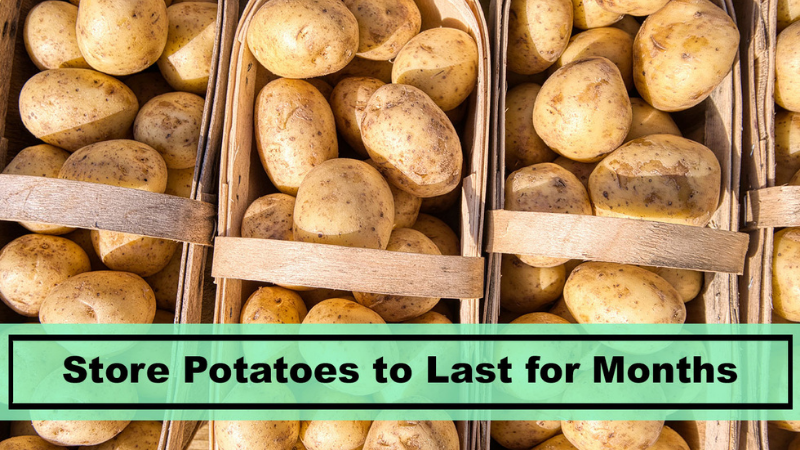
In case you are growing potatoes to store, let them grow in the ground. Why? Because you must keep potatoes somewhere cold, but not frozen if you want them to keep well. To find out the best harvesting time based on where you live.
It is best to harvest potatoes on a sunny morning. As soon as you dig the tubers, we recommend letting them dry on top of the elevated beds for several hours.
They toughen their skin during the short period of drying. Therefore, they are now ready for storage. Any loose soil on the tubers should be gently brushed off. Use paper bags of double thickness to store them securely for a more extended period.
7 Useful Tips to Grow Potatoes Fast
1. Fertilize correctly


The half of the fertilizer you will use while seeding the potatoes. As the plants grow, the remaining portions should be added if necessary.
2. Do heavy mulching
Moisture is crucial to the growth of potatoes. By putting a generous amount of mulch on the soil, you will help to keep it moist.
Leaf chips, straws, or plastic mulch can be used as mulch. No matter which type you choose, nothing is wrong.
3. Cover the potatoes


During late frost conditions, you could cover your seeded potatoes with a blanket. To avoid being nipped in the back, apply this technique. Upon removing the blanket, the plants will begin to grow again.
As an alternative, you are free to let the potatoes frost. However, they will take time to become fully mature.
4. Never keep the planting area vacant
After harvesting potatoes, begin planting new crops. Do not just leave that spot bare after harvesting potatoes if you planted an early variety.
In potatoes’ growing soil, there are many nutrient-rich elements. Squash, beans, and tomatoes are among the many crops you can plant on this soil.
5. Freshly cut seeds
Don’t try to cut tiny potato seeds. Dehydration is a common problem with them. Plus, healing happens very slowly, which will lead to slow growth.
Humidity and oxygen are necessary for the growth of these seeds. Regardless of the type of seeds, they can be treated before planting.
6. Diseases
Pests can cause diseases to affect potatoes. Potato beetles and bugs are examples of such pests. Using organic pesticides will help prevent these insects from destroying the potatoes.
Additionally, by using companion plants, you can avoid bugs. Distracting and confusing bugs is what they do.
7. Weed
Potatoes may not grow well in the plot if weeds grow there. Planting seeds must be followed by removing the weed. Mulch can help you prevent weed problems in the future.
Weeds will not be able to grow as this will distract them. Temperature is regulated in the soil by this mechanism.
Try Vegetative Propagation Method to Grow Potatoes
Growing potatoes from the vegetative propagation method are one of the best practice of growing potatoes faster than usual time.
To guide you step by step we created content on “How to Grow Potatoes with Vegetative Propagation?”
What is The Best Spacing Between Potato Seeds?
Potatoes can be harvested in various ways, depending on their type. It’s a fascinating fact that growing potatoes is a matter of spacing them apart widely.
If you are interested in growing small-sized potatoes, we recommend keeping around 9 inches gap between the spuds.
If so, make sure you are planting them on healthy and fertile soil. Healthy growing conditions are crucial to the potato’s success.
On the other hand, if you are planning to grow more giant potatoes, make sure to keep a minimum of a square foot of space between seeds.
Expert gardeners suggested leaving at least 17 to 35 inches between rows when planting your crop.
What are the ways to grow potatoes?
Potatoes can be easily grown in a variety of ways. The basic methods include those outlined below.
- Potatoes can also be grown in hilled rows, which is the cheapest method. High-quality soil is necessary for this method, as growth can be limited by it.
- It is the least digging to use the straw mulch method. In addition to conserving soil, mulch also prevents weed growth in this method. Since no digging is needed for the harvest, it is effortless
- The most extensive yield can be achieved by using raised beds. You can get a lot of potatoes with this method. In soil that is heavy and poorly drained, it is a good option.
- You can also grow potatoes in wooden boxes. You can add soil and slats to increase yields to those of raised beds
- If your yard is wet, wired cylinders are the most suitable method. Harvesting potatoes is a simple procedure that involves lifting a cylinder and removing the soil from the tubers.
- Grow Potatoes in a bag for the most straightforward method. You will find different types of bags in different sizes in supermarkets.
- Garbage bags are also readily available, and you can use them to grow potatoes. Black polyethylene absorbs more sunlight and makes these plastics suitable for growing plants.
Should You Harvest Potatoes After Maturity?
No, you should not harvest potatoes after maturity.
Upon reaching maturity, potato plants will not grow anymore. Tubers that remain in the ground fail to grow anymore. However, thicker and harder skin continues to develop. Stored potatoes will last longer when treated like this.
Which Fertilizer is Most Effective for Potatoes?


As potatoes are root vegetables that grow underground, they are more likely to grow well when phosphate and potassium are present. Use a granular fertilizer that contains potassium and phosphate in the proper amounts. It can be 8-24-24 or 5-10-10.
Can a potato that has not sprouted be planted?
No! Due to the lack of seeds, they need to be grown in a different way from other vegetables. Though it is not mandatory to pre-sprout, or chit, your potatoes will start growing earlier this way. Higher yields are guaranteed by using this method.
What is the best way to increase potato yield?
The best way is to keep the seed of the potatoes at the container base. After that, you will add 4 inches of soil and a little amount of water. The container should be filled with soil as the plants grow until a one-inch gap between the soil and the container’s roof.
Is it faster to sprout potatoes in the dark?
No! But Dark is suitable for sprouting potatoes. However, the light should not be introduced until the sprouts begin to appear. For “chitting,” sprouts should be approximately half an inch long (1 cm).
What is the average number of potatoes per plant?
On average, gardeners can expect to harvest five to ten potatoes per plant, assuming all conditions are ideal. By planting 0.907 kg of potato seeds, you can grow about 50 pounds of potatoes.
The yield of a plant depends on how well you take care of it during the growing season and the type of potatoes you have selected.
Conclusion
We are assuming that everything has been done correctly and your potatoes are ready, now is the time to start digging. Seeing them in the open is finally a pleasure.
No matter if you dig them all together, it’s your choice. Or, it’s OK to take them out whenever you need them.
Families can enjoy harvesting together! It will undoubtedly be a hit with kids. Digging and getting dirty are among the kid’s favorite activities!
Children would be so happy if they got to eat something that they collected from the ground.
Hopefully, we got you covered everything on how long does it take for potatoes to grow.
Last update on 2023-01-28 / Affiliate links / Images from Amazon Product Advertising API
 |
 |
 |
 |

About Lee Safin
Lee Safin was born near Sacramento, California on a prune growing farm. His parents were immigrants from Russia who had fled the Bolshevik Revolution. They were determined to give their children a better life than they had known. Education was the key for Lee and his siblings, so they could make their own way in the world. Lee attended five universities, where he studied plant sciences and soil technologies. He also has many years of experience in the U.S. Department of Agriculture as a commercial fertilizer formulator.
Thoughts on "How Long Does It Take For Potatoes to Grow? How to Grow Potatoes Properly?"
 |
 |
 |
 |
Get FREE Gardening Gifts now. Or latest free toolsets from our best collections.
Disable Ad block to get all the secrets. Once done, hit any button below
 |
 |
 |
 |